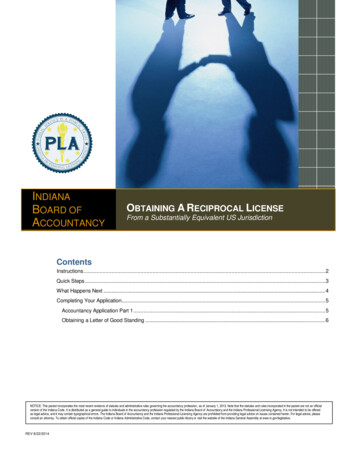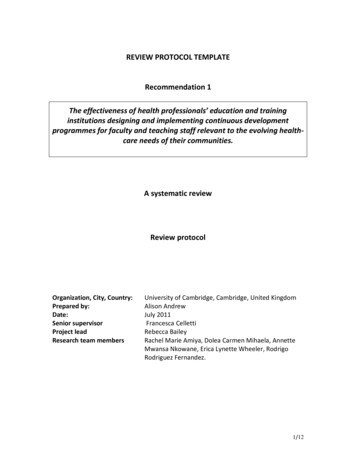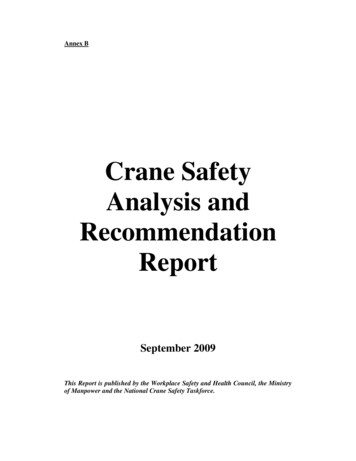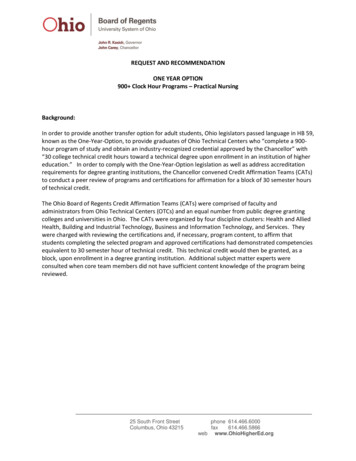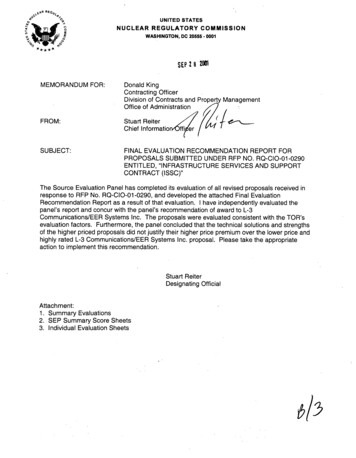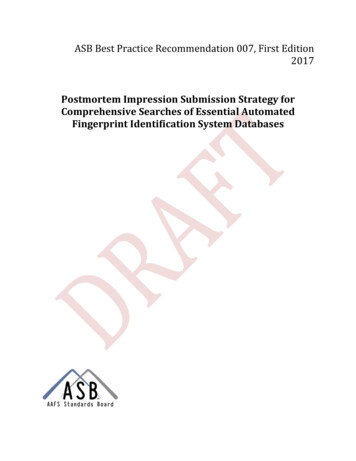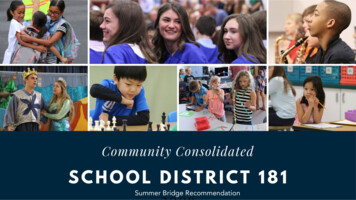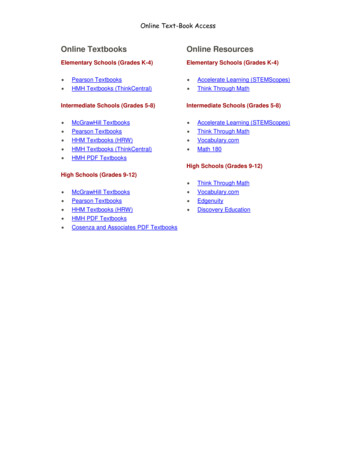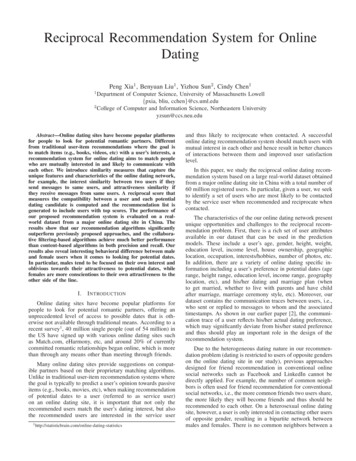
Transcription
Reciprocal Recommendation System for OnlineDatingPeng Xia1 , Benyuan Liu1 , Yizhou Sun2 , Cindy Chen11Department of Computer Science, University of Massachusetts Lowell{pxia, bliu, cchen}@cs.uml.edu2College of Computer and Information Science, Northeastern Universityyzsun@ccs.neu.eduAbstract—Online dating sites have become popular platformsfor people to look for potential romantic partners. Differentfrom traditional user-item recommendations where the goal isto match items (e.g., books, videos, etc) with a user’s interests, arecommendation system for online dating aims to match peoplewho are mutually interested in and likely to communicate witheach other. We introduce similarity measures that capture theunique features and characteristics of the online dating network,for example, the interest similarity between two users if theysend messages to same users, and attractiveness similarity ifthey receive messages from same users. A reciprocal score thatmeasures the compatibility between a user and each potentialdating candidate is computed and the recommendation list isgenerated to include users with top scores. The performance ofour proposed recommendation system is evaluated on a realworld dataset from a major online dating site in China. Theresults show that our recommendation algorithms significantlyoutperform previously proposed approaches, and the collaborative filtering-based algorithms achieve much better performancethan content-based algorithms in both precision and recall. Ourresults also reveal interesting behavioral difference between maleand female users when it comes to looking for potential dates.In particular, males tend to be focused on their own interest andoblivious towards their attractiveness to potential dates, whilefemales are more conscientious to their own attractiveness to theother side of the line.I.I NTRODUCTIONOnline dating sites have become popular platforms forpeople to look for potential romantic partners, offering anunprecedented level of access to possible dates that is otherwise not available through traditional means. According to arecent survey1, 40 million single people (out of 54 million) inthe US have signed up with various online dating sites suchas Match.com, eHarmony, etc, and around 20% of currentlycommitted romantic relationships began online, which is morethan through any means other than meeting through friends.Many online dating sites provide suggestions on compatible partners based on their proprietary matching algorithms.Unlike in traditional user-item recommendation systems wherethe goal is typically to predict a user’s opinion towards passiveitems (e.g., books, movies, etc), when making recommendationof potential dates to a user (referred to as service user)on an online dating site, it is important that not only therecommended users match the user’s dating interest, but alsothe recommended users are interested in the service user1 and thus likely to reciprocate when contacted. A successfulonline dating recommendation system should match users withmutual interest in each other and hence result in better chancesof interactions between them and improved user satisfactionlevel.In this paper, we study the reciprocal online dating recommendation system based on a large real-world dataset obtainedfrom a major online dating site in China with a total number of60 million registered users. In particular, given a user, we seekto identify a set of users who are most likely to be contactedby the service user when recommended and reciprocate whencontacted.The characteristics of the our online dating network presentunique opportunities and challenges to the reciprocal recommendation problem. First, there is a rich set of user attributesavailable in our dataset that can be used in the predictionmodels. These include a user’s age, gender, height, weight,education level, income level, house ownership, geographiclocation, occupation, interests/hobbies, number of photos, etc.In addition, there are a variety of online dating specific information including a user’s preference in potential dates (agerange, height range, education level, income range, geographylocation, etc), and his/her dating and marriage plan (whento get married, whether to live with parents and have childafter marriage, marriage ceremony style, etc). Moreover, ourdataset contains the communication traces between users, i.e.,who sent or replied to messages to whom and the associatedtimestamps. As shown in our earlier paper [2], the communication trace of a user reflects his/her actual dating preference,which may significantly deviate from his/her stated preferenceand thus should play an important role in the design of therecommendation system.Due to the heterogeneous dating nature in our recommendation problem (dating is restricted to users of opposite genderson the online dating site in our study), previous approachesdesigned for friend recommendation in conventional onlinesocial networks such as Facebook and LinkedIn cannot bedirectly applied. For example, the number of common neighbors is often used for friend recommendation for conventionalsocial networks, i.e., the more common friends two users share,the more likely they will become friends and thus should berecommended to each other. On a heterosexual online datingsite, however, a user is only interested in contacting other usersof opposite gender, resulting in a bipartite network betweenmales and females. There is no common neighbors between a
service user and recommended users since they are of differentgenders. To this end, we will need to devise appropriatemechanisms that accounts for the special characteristics of theonline dating network.The contributions of this paper are summarized as follows.We present a recommendation system that aims to matchusers who are most likely to communicate with each other.We introduce similarity measures that capture the uniquefeatures and characteristics of the heterogeneous online datingnetwork. In particular, we build a preference model for eachservice user based on the attributes of users who have beencontacted by the service user. We also characterize the interestsimilarity between two users if they send messages to sameusers, and attractiveness similarity if they receive messagesfrom same users. Based on these similarity measures wecompute the compatibility between a service user and potentialdating candidates and the recommendation list is generated toinclude candidates with top scores. Using a combination ofsimilarity measures, we construct a set of content-based andcollaborative filtering-based algorithms with different measuresof compatibility between users.We evaluate the performance of our proposed algorithmson the real-world online dating dataset that consists of 200,000users and around two million messages over a period of twomonths. Our results show that both content-based and collaborative filtering-based recommendation algorithms presentedin our paper significantly outperform previously proposed approaches. Also, compared to the content-based algorithms, ourcollaborative filtering-based algorithms achieve much betterperformance in both precision and recall.Our results also reveal interesting behavioral differencebetween male and female users when it comes to lookingfor potential dates. Among the collaborative filtering-basedalgorithms, the best performance for male users is achievedwhen the recommender captures the attractiveness of recommended users to the service user and interest from theservice user in recommended users. On the contrary, thebest performance for females is achieved when recommendedusers are interested in the service user and the service useris attractive to recommended users. The results show thatwhen looking for potential dates, males tend to be focused ontheir own interest and oblivious towards their attractiveness topotential dates, while females are more conscientious to theirown attractiveness to and interest from the other side on theline.The rest of the paper is organized as follows. Section IIdescribes the related work on reciprocal recommendation aswell as reciprocal relation prediction in online social networks.Section III presents the reciprocal recommendation algorithmswe proposed. Section IV describes the characteristics of ourdataset and presents the performance of our proposed algorithms. Finally, we conclude our paper in Section V.II.R ELATED W ORKA few studies on the analysis of user behavior of onlinedating sites have provided valuable guidelines to design recommendation system for online dating. In [2], the authorsanalyze how user’s sending and replying behavior correlatewith several important user attributes, such as age, income,education level, and number of photos, etc., and how much auser’s actual preference deviates from his/her stated preference.The findings also correspond to the result of [16] that therecommendation system built on user’s implicit preferenceoutperforms that built on user’s explicit preference.There exists research that aims to predict user reciprocityin various online social networks. In [17], a machine learningbased approach is proposed to find plausible candidates ofbusiness partners using firm profiles and transactional relationsbetween them. The authors of [11] propose a Triad FactorGraph model to deal with two-way relation prediction inonline social networks. In [3], both user-based and graphbased features are applied in a machine learning frameworkto predict user replying behavior in online dating networks.A new collaborative filtering approach called CLiMF [14]is proposed to learn latent factors of users and items andimproves the performance of top-k recommendations for recommending friends or trustees on Epinions and Tuenti. Further,they improve the algorithm by optimizing Expected ReciprocalRank, an evaluation metric that generalizes reciprocal rankin order to incorporate user feedback with multiple levels ofrelevance in [15].There have been recently several studies on the peopleto people recommendation for online social networks. Bothcontent based algorithm and collaborative filtering method areapplied to recommend users to follow in Twitter [10]. A LDAbased method is employed in [13] to discover communities inTwitter-style online social networks, and matrix factorizationare applied on each community to provide recommendations.For online dating recommendations, the authors in [12] and[7] analyzed the characteristics of reciprocal recommendationsin detail. In particular, [12] considers both local utility (users’mutual preference) and global utility (overall bipartite network), and proposes a generalized reciprocal recommendationframework for both online dating sites and online recruitingsites. A content based reciprocal algorithm (RECON) proposedin [7] learns the preference of both sides of users and definesa new evaluation metric (success rate) to evaluate the performance of their algorithm. In their following work [8], [9],RECON is extended to consider both positive and negativepreference, and collaborative filtering is applied with stochasticmatching algorithm. In [4], a hybrid collaborative filteringbased algorithm that takes reciprocal links into account is proposed and shown to have good performance in recommendingboth initial and reciprocal contacts. A recent study of [18]finds that users with similar profiles like and dislike similarpeople, and are liked and disliked by similar people. Thishypothesis is used to build a content-collaborative reciprocalrecommender, which is evaluated on a popular online datingdataset. In [6], collaborative filtering algorithms are used tocapture the reciprocity in people to people recommendation.The authors in [5] propose a two-side matching framework foronline dating recommendations and design a Latent DirichletAllocation (LDA) model to learn the user preferences from theobserved user messaging behavior and user profile features.The studies most relevant to our online dating recommendation problem are [7] and [4], in which a contentbased algorithm (RECON) and a collaborative filtering-basedalgorithm (HCF) was presented and shown to outperform other
approaches. In this paper we will compare the performance ofour proposed algorithms with these two algorithms.III.R ECOMMENDATION S YSTEMIn this section, we propose a generalized reciprocal recommendation system that aims to match people with mutualinterest in each other. We also introduce two previously proposed approaches, namely, a content-based algorithm RECON[7] and a hybrid collaborative filtering algorithm (HCF) [4] forcomparison.A. System DesignThe success of a reciprocal recommendation system lies inits ability to recommend users with whom the service user hasmutual interest and thus they are likely to communicate witheach other. The interaction records between a pair of users area good indicator of actual interest and attractiveness betweenthe sender and receiver. If a recommended user matches theservice user’s interest, the service user will be more likely toapproach the recommended user. Also, if the service user’sattractiveness is compatible with the recommended user’sinterest, the recommended user will be more likely to replyto the service user when contacted.M1M2M3M4F1F2F3F4Initial ContactFig. 1.ReplyExample of an online dating recommendation problemFigure 1 depicts an example of an online dating network.Based on user attributes and their communication traces, ourgoal is to match users with mutual interest in each other, forexample, M3 and F3, M4 and F4. In the following we willdescribe how to measure the similarity between a pair of usersin terms of their dating interest and attractiveness, and how toconstruct various recommendation algorithms based on thesesimilarity measures.Our reciprocal recommendation system is comprised of thefollowing four major components.Extracting User Based Features: Whe
Abstract—Online dating sites have become popular platforms for people to look for potential romantic partners. Different from traditional user-item recommendations where the goal is to match items (e.g., books, videos, etc) with a user’s interests, a recommendation system for online dating aims to

